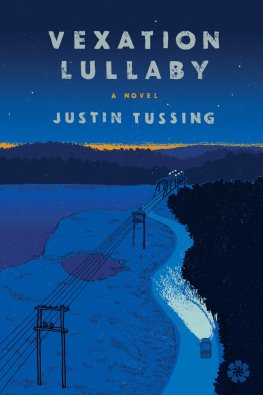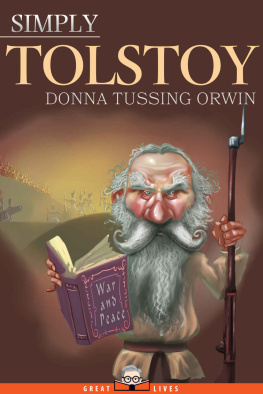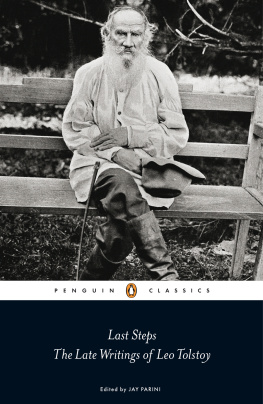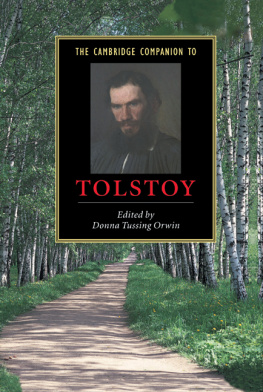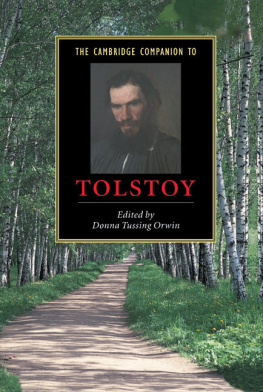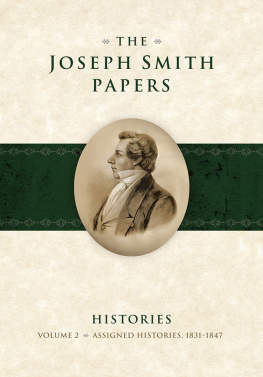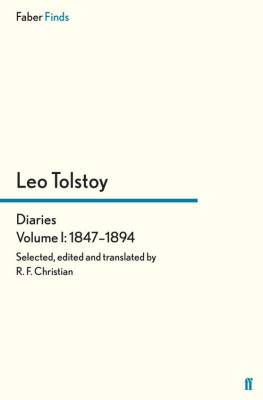Orwin Donna Tussing - Tolstoys Art and Thought, 1847-1880
Here you can read online Orwin Donna Tussing - Tolstoys Art and Thought, 1847-1880 full text of the book (entire story) in english for free. Download pdf and epub, get meaning, cover and reviews about this ebook. year: 2013, publisher: Princeton University Press, genre: Science. Description of the work, (preface) as well as reviews are available. Best literature library LitArk.com created for fans of good reading and offers a wide selection of genres:
Romance novel
Science fiction
Adventure
Detective
Science
History
Home and family
Prose
Art
Politics
Computer
Non-fiction
Religion
Business
Children
Humor
Choose a favorite category and find really read worthwhile books. Enjoy immersion in the world of imagination, feel the emotions of the characters or learn something new for yourself, make an fascinating discovery.
- Book:Tolstoys Art and Thought, 1847-1880
- Author:
- Publisher:Princeton University Press
- Genre:
- Year:2013
- Rating:5 / 5
- Favourites:Add to favourites
- Your mark:
- 100
- 1
- 2
- 3
- 4
- 5
Tolstoys Art and Thought, 1847-1880: summary, description and annotation
We offer to read an annotation, description, summary or preface (depends on what the author of the book "Tolstoys Art and Thought, 1847-1880" wrote himself). If you haven't found the necessary information about the book — write in the comments, we will try to find it.
Tolstoys Art and Thought, 1847-1880 — read online for free the complete book (whole text) full work
Below is the text of the book, divided by pages. System saving the place of the last page read, allows you to conveniently read the book "Tolstoys Art and Thought, 1847-1880" online for free, without having to search again every time where you left off. Put a bookmark, and you can go to the page where you finished reading at any time.
Font size:
Interval:
Bookmark:

TOLSTOYS ART AND THOUGHT, 18471880
TOLSTOYS ART AND THOUGHT,
18471880
Donna Tussing Orwin
PRINCETON UNIVERSITY PRESS PRINCETON, NEW JERSEY
Copyright 1993 by Princeton University Press
Published by Princeton University Press, 41 William Street,
Princeton, New Jersey 08540
In the United Kingdom: Princeton University Press,
Chichester, West Sussex
All Rights Reserved
Library of Congress Cataloging-in-Publication Data
Orwin, Donna Tussing, 1947
Tolstoys art and thought, 18471880 / Donna Tussing Orwin.
p. cm.
Includes bibliographical references and index.
ISBN 0-691-06991-3
1. Tolstoy, Leo, graf, 18281910Criticism and interpretation. 2. Tolstoy, Leo, graf, 18281910Philosophy. 3. Philosophy in literature. I. Title.
PG3415.P5078 1993
891.73'3dc20 92-37860
This book has been composed in Adobe Palatino
Princeton University Press books are printed
on acid-free paper and meet the guidelines
for permanence and durability of the Committee
on Production Guidelines for Book Longevity
of the Council on Library Resources
Printed in the United States of America
10 9 8 7 6 5 4 3 2 1
To my parents
Contents
Acknowledgments
THIS BOOK draws extensively on the tradition of Tolstoy scholarship from his day to our own. My frequent references to other scholars within the text and in footnotes is meant to reflect my indebtedness to that tradition and my sense of being part of an ongoing discussion about the great writer.
My approach to the study of Tolstoy owes a great deal to my teachers, whom I would like to take this opportunity to thank. George Gibian was my first teacher of Tolstoy. With Patricia Carden I learned how to analyze a text, and I have subsequently learned from her own writings on Tolstoy. Antonia Glasse, by her example and her teaching, taught me to love scholarship. Allan Bloom introduced me to the study of philosophy and also taught me to neglect neither the real nor the ideal in human nature. In graduate courses I took with Donald Fanger I learned the value of literary history, and of placing myself clearly within the tradition of literary scholarship. Kiril Taranovsky taught me to look to Russian poetry in order to understand Russian prose. Kathryn Feuer inspired me with her personal generosity and her humane, intelligent approach to the study of Tolstoy.
I have also benefited greatly over the years from conversations about this project with friends and colleagues. Kathleen Parth has encouraged my work on Tolstoy over the years. Leslie OBell, Ralph Lindheim, James Morrison, Gary Saul Morson, Werner Dannhauser, Arthur Melzer, and Anna Lisa Crone have read and commented on all or parts of the manuscript. Caryl Emerson and Richard Gustafson read the manuscript for Princeton University Press and offered helpful suggestions. I am grateful to the National Endowment of the Humanities for fellowship support of this project in 19881989, and to the Centre for Russian and East European Studies at the University of Toronto for its continuing support. The editors at Princeton University Press, and especially Rita Bernhard, my copy editor, have been most helpful. My husband, Clifford Orwin, has been my main support in this as in all my endeavors.
Note on Documentation
REFERENCES to The Cossacks , War and Peace , and Anna Karenina are by part and/or chapter and, like citations from the Jubilee edition of Tolstoys works, are included in the text. Textual references to the Jubilee edition are cited throughout with volume numbers and page numbers only. War and Peace I treat as fifteen parts divided into chapters. In other words, I ignore the further complication in the Russian original of the division into four or six books (depending on the edition used). All other citations are in footnotes, with two exceptions. When a work is cited more than once consecutively, the first citation is in a footnote with subsequent ones cited as ibid. and in the text; if a citation consists of a page number only, it is included in the text. All translations from the Russian, unless otherwise noted, are my own or modified versions of Aylmer Maudes translations of Tolstoy.
Polnoe sobranie sochinenii . 90 vols. Moscow: Gosudarstvennoe izdatelstvo khudozhestvennaia literatura, 19281958.
TOLSTOYS ART AND THOUGHT, 18471880
No form of idealism is harmful, so long as there is sensuousness. If you hold firmly to the earth, it stretches out the soul.
(Diary; 18 December 1856)
The Decline of art is the truest sign of the decline of civilization. When there are ideals, then works of art are produced in the name of these ideals; when there are none, as is true with us, there are no works of art! Theres play with words, play with sounds, play with images.
(9 February 1908; reported by Gusev in L. N. Tolstoi v vospominaniiakh sovremennikov , 2:219)
Introduction
THIS BOOK is an attempt to reconstruct the ideas that led Tolstoy to write the masterpieces of his youth and middle age. Its three parts roughly coincide with the first three decades of Tolstoys creative life. In the first, on the 1850s, I try to reconstruct what Tolstoys initial vision might have been. The second part, on the 1860s, consists mainly of an analysis of The Cossacks and War and Peace , which are the fruits of Tolstoys early humanism. The final section of the book deals with the disintegration of this initial vision under personal, philosophical, and historical pressures. I treat Anna Karenina as a product of Tolstoys emerging new understanding, and I compare it to War and Peace .
I adhere to three general assumptions about Tolstoy, each of them familiar in some form to scholars. The first goes back to perhaps the most important essay on Tolstoy ever written, Apollon Grigorevs The Early Works of Count L. N. Tolstoy [ Rannie proizvedeniia gr. L. N. Tolstogo ], published in 1862. In it Grigorev argued that Tolstoy was a writer in search of an idea that would rescue him from the nihilismGrigorev uses this wordgenerated by his own analytical powers. Grigorev thereby introduced the idea of Tolstoy as a divided man, who exposed the false idols of others yet longed to replace them with true gods who could withstand his analysis. In a variation on this theme, the populist N. K. Mikhailovsky declared outright that Tolstoys thoughts, and hence his writings, were a confusing mixture of right- and left-wing ideas. After Tolstoys well-publicized religious conversion and his turn away from literature in the early 1880s, his contradictions seemed even more glaring. The Nietzschean writer and critic D. S. Merezhkovsky explored them in Tolstoi as Man and Artist (1902). Neither Merezhkovsky, nor Maxim Gorky (in his memoirs of Tolstoy, first published in 1919), thought much of Tolstoys religious theories. Merezhkovsky called him the Seer of the Flesh, implying that Tolstoy understood the body, but not the soul.
The formalist critic Boris Eikhenbaum introduced a new twist to this persistent theme of Tolstoys divided nature. In his first book about Tolstoy, entitled The Young Tolstoy [ Molodoi Tolstoi ], Eikhenbaum, reacting against earlier critics who in his opinion wrote biography and not criticism, concentrated on Tolstoyan texts and their literary relation to earlier texts.
Isaiah Berlin, in his famous essay The Hedgehog and the Fox (1953), made a similar point but gave it a broader, psychological and philosophical interpretation. Berlin, too, saw both details, or particularities, and generalizations in Tolstoys work. As a political liberal, however, Berlin had a different view of Tolstoyan nihilism than Grigorev did, or even Eikhenbaum. For Berlin, it could be the positive basis of a pluralistic society in which individualsdetailswould be fully appreciated and protected. In Berlins striking metaphor, Tolstoy was a fox (someone who understood detail) who wanted to be a hedgehog (a systematizer):
Next pageFont size:
Interval:
Bookmark:
Similar books «Tolstoys Art and Thought, 1847-1880»
Look at similar books to Tolstoys Art and Thought, 1847-1880. We have selected literature similar in name and meaning in the hope of providing readers with more options to find new, interesting, not yet read works.
Discussion, reviews of the book Tolstoys Art and Thought, 1847-1880 and just readers' own opinions. Leave your comments, write what you think about the work, its meaning or the main characters. Specify what exactly you liked and what you didn't like, and why you think so.


